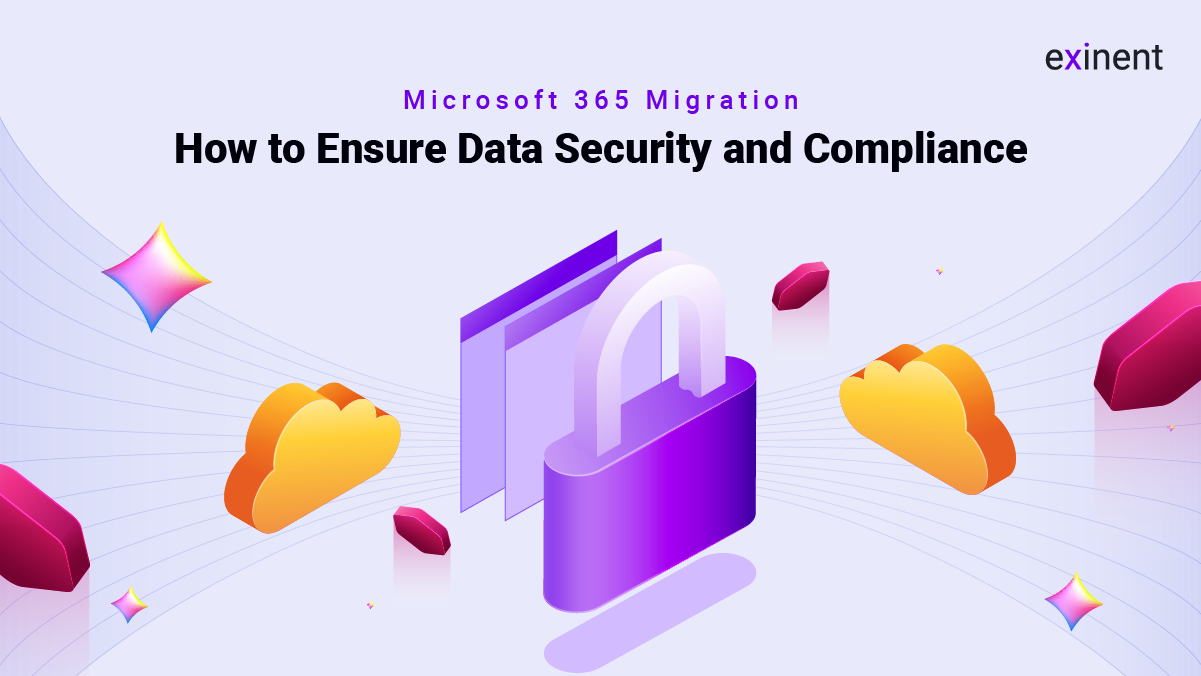
As businesses increasingly transition to cloud-based solutions, Microsoft 365 migration has become a common strategic move. Microsoft 365 offers a suite of powerful tools and services designed to enhance productivity, collaboration, and overall operational efficiency. However, with this shift comes a crucial responsibility: ensuring data security and compliance. At Exinent, we understand that safeguarding your data during this migration is paramount. In this blog, we’ll explore essential strategies to ensure your Microsoft 365 migration is secure and compliant.
Understanding the Importance of Data Security and Compliance
Data security and compliance are critical concerns for any organization undertaking a Microsoft 365 migration. Data security involves protecting sensitive information from unauthorized access and breaches, while compliance refers to adhering to regulatory requirements relevant to your industry. Ensuring both aspects are properly managed during migration is essential to avoid potential risks and legal issues.
1. Develop a Comprehensive Migration Plan
A well-structured migration plan is the foundation of a successful Microsoft 365 migration. Begin by conducting a thorough assessment of your current IT environment, including identifying sensitive data, understanding regulatory requirements, and determining your security needs.
Create a detailed migration roadmap that outlines each step of the process, from data preparation and backup to actual migration and post-migration checks. This plan should include risk management strategies and contingency measures to address any unforeseen issues.
2. Implement Data Encryption
Data encryption is a key measure for protecting sensitive information both during and after migration. Microsoft 365 offers robust encryption capabilities, including data encryption at rest and in transit. Ensure that encryption is enabled for all data moving between your on-premises systems and Microsoft 365.
Additionally, consider using additional encryption tools or services if necessary to further secure your data. This will help protect against data breaches and unauthorized access during the migration process.
3. Conduct Thorough Data Backups
Before initiating the Microsoft 365 migration, it is crucial to perform comprehensive data backups. This precaution ensures that you have a secure copy of your data in case anything goes wrong during the migration.
Regularly back up all critical data and verify the integrity of these backups. Having reliable backups will provide peace of mind and facilitate quick recovery in the event of data loss or corruption.
4. Use Multi-Factor Authentication (MFA)
Multi-Factor Authentication (MFA) adds an extra layer of security to your Microsoft 365 accounts by requiring users to verify their identity through multiple methods. MFA typically involves a combination of something the user knows (password), something they have (a mobile device), and something they are (biometric verification).
Implementing MFA for all user accounts enhances security and reduces the risk of unauthorized access during and after the migration process. It is a crucial step in ensuring that only authorized individuals can access your Microsoft 365 environment.
5. Ensure Compliance with Regulations
Compliance with industry-specific regulations is a fundamental aspect of data security. Familiarize yourself with the regulations that apply to your organization, such as GDPR, HIPAA, or CCPA.
Microsoft 365 provides various tools and features to help organizations meet compliance requirements, including data loss prevention (DLP) policies, audit logs, and compliance centers. Utilize these features to monitor and manage compliance throughout the migration process.
6. Monitor and Audit Data Access
Continuous monitoring and auditing of data access are essential for maintaining security and compliance. Microsoft 365 offers built-in auditing and reporting tools that allow you to track user activity and access to sensitive information.
Regularly review audit logs to identify any unusual or unauthorized access attempts. Setting up alerts for suspicious activities can help you quickly address potential security threats and ensure that your data remains protected.
7. Train and Educate Your Team
Proper training and education for your team are vital for maintaining data security and compliance. Ensure that all employees involved in the Microsoft 365 migration process are aware of best practices for data protection and compliance.
Provide ongoing training on security protocols, data handling procedures, and the importance of compliance. An informed and vigilant team will be better equipped to handle potential security issues and maintain a secure Microsoft 365 environment.
8. Engage with Experts
Finally, consider partnering with experts like Exinent to assist with your Microsoft 365 migration. Our team of professionals specializes in cloud migrations and can provide valuable guidance on ensuring data security and compliance throughout the process.
With our expertise, you can navigate the complexities of migration with confidence, knowing that your data is in safe hands.
Conclusion
Ensuring data security and compliance during a Microsoft 365 migration is essential for protecting your organization’s sensitive information and meeting regulatory requirements. By developing a comprehensive migration plan, implementing robust security measures, and engaging with experts, you can successfully navigate the migration process while safeguarding your data.
At Exinent, we are committed to helping businesses achieve a smooth and secure Microsoft 365 migration. Contact us today to learn more about how we can support your migration needs and ensure the security and compliance of your data.
For more information, visit www.exinent.com.
